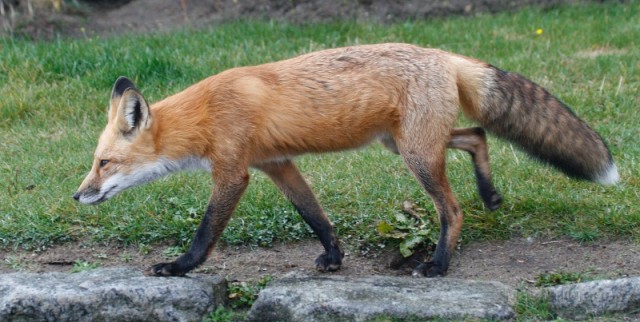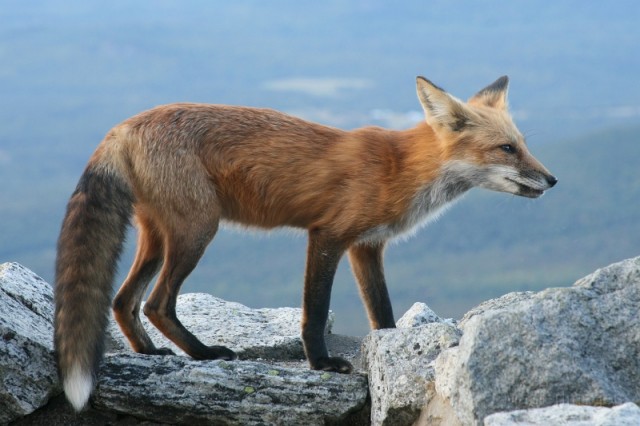Over the past couple years I’ve occasionally seen a Red Fox in my neighborhood. I first noted fox scats on the rocks which border my steps – something which caught Wren’s attention as well. Sometimes when something out of the ordinary has visited the yard I can tell by how excited Wren is when I let her out first thing in the morning. I finally had my first sighting of the fox as it was crossing the street and I have seen it several times since. I’ve always seen the fox at night, usually when I’m outside listening to migrating songbirds or arriving home late at night.
And while a fox in town may surprise some people, there are many wooded patches in and around our Adirondack villages which can easily support them. It is one of the great things about living in or visiting this area – wildlife is afforded plenty of room to live and in close proximity to people. Even with that, Red Foxes are well known by their ability to adapt to people and to live in much larger urban areas. Cities like Philadelphia, London, and New York all have their Red Fox populations even in high density areas. The foxes survive, sometimes finding food which people provide, while dodging the threats of people, their dogs, and cars.
The Red Fox’s adaptability and savvy in living with people are almost legendary as are its abilities in outwitting hunters and their dogs. And while foxes do show some amazing behaviors to give hunters the slip, the real Red Fox is not a creature with mythical cunning; it is an adaptable animal that has learned many ways to deal with people. 
The fluffy reddish-orange fur of Red Foxes is well known and gives them an appearance of being larger than they are. In truth adults generally weigh between 10 and 15 pounds with some weighing less. They have black stockings and black on their ears with a white tip on their tail. There are a few other color phases including a “cross phase” which is darker in color with a dark cross across its shoulders.
Part of their adaptability stems from their wide ranging diet which consists of rodents such as mice, voles, and squirrels, as well as a rabbits, hares, shrews, birds, eggs, insects, and amphibians. Their tactic of hunting small rodents is often to stalk close using their ears to pick up the faintest rustle beneath the leaves or snow and then to launch themselves in a nose-diving-pounce to trap and catch the animal. Watching a fox hunt in this manner is a great deal of fun. They also eat a large amount of vegetation material, which includes a variety of berries, grapes, apples, acorns, corn, beechnuts etc. As a result their scat often shows seeds from plants mixed with digested animal matter. In addition, foxes will eat carrion, roadkill, and in human areas take part in pet food or garbage on occasion.
The timing of mating in Red Foxes varies some according to latitude, but it generally occurs during the winter – January through March is common. This may help the parents and kits in catching young rodents which become available in the spring and summer. Their dens for the young may be upturned trees, rocky crevices, or often a burrow which the parents have dug – sometimes taking over an old burrow from another species such as a groundhog. Both parents tend the young which generally stay with the parents until the fall – young females sometimes staying with the parents longer. The females also disperse less widely from the parents than do the males when it is time to leave.
Foxes are generally most active at night but can be found at times hunting during the day particularly in winter (when food is scarce) or when adults have young (when they must hunt constantly). And they can be seen almost anywhere in our region. They inhabit the entire North Country region and much of North America, and can be seen in our area from low wetlands to the mountain tops. They tend to prefer forest edges and openings where they hunt for their prey and look for berries along the edges of fields, in brushy shrubby habitat, and in meadows. I see them regularly when I am out – whether in the Champlain Valley or hiking in the mountains. After all, one even visits my yard! So keep your eyes open for this common, but fascinating Adirondack species.


